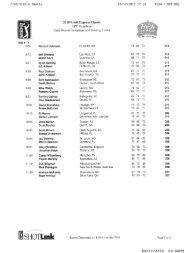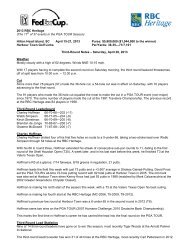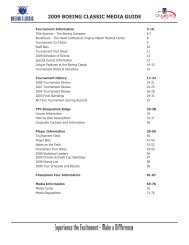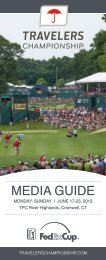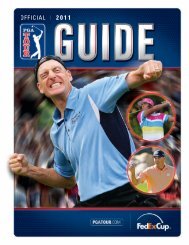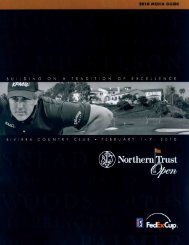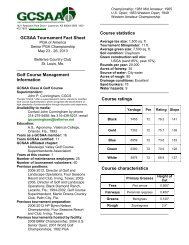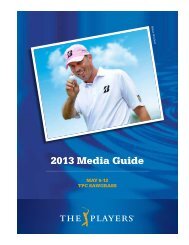2004 PGA TOUR Media Guide
2004 PGA TOUR Media Guide
2004 PGA TOUR Media Guide
Create successful ePaper yourself
Turn your PDF publications into a flip-book with our unique Google optimized e-Paper software.
SECTION 9 / ADDITIONAL INFOWorld Golf Hall of Fame <strong>PGA</strong> <strong>TOUR</strong> Pioneers/MembersWillie Anderson (1975)The son of a Scottish greenskeeper, Anderson emigrated to the U.S. at age 15and became the first dominant player in America. He won the U.S. Open fourtimes before age 27, including three consecutively from 1903 to 1905.Anderson finished in the top five 11 of the 14 times that he competed in thenational championship.Tommy Armour (1976)A native of Edinburgh, the “Silver Scot” won the 1927 U.S. Western Open, the1930 <strong>PGA</strong> Championship and the 1931 British Open. One of golf’s mostrespected instructors, Armour excelled despite injuries suffered in World WarI that left him with one eye and with metal plates in his head and arm.Jim Barnes (1989)An assistant pro in England at age 15, Barnes came to America at 19, andbetween 1916 and 1925 won all the major tournaments of his day: theWestern Open in 1914, 1917 and 1919; the first two <strong>PGA</strong> Championships in1916 and 1919; the 1921 U.S. Open; and the 1925 British Open.Deane Beman (2000)Commissioner of the <strong>PGA</strong> <strong>TOUR</strong> from 1974-1994, he created the ChampionsTour, the Nationwide Tour and developed the “stadium golf” concept. As aplayer, Beman won the 1959 British Amateur, the 1960 and 1963 U.S.Amateurs, competed on four U.S. Walker Cup Teams and captured four <strong>PGA</strong><strong>TOUR</strong> titles.Tommy Bolt (2002)Bolt was best known for his impeccable ball striking, colorful personality,stylish clothes and occasional temper tantrums. He did not join the U.S. touruntil 1950 when he was 32. Bolt won the U.S. Open at age 40 and captured15 <strong>TOUR</strong> titles. He was a founding member of the Champions Tour.Julius Boros (1982)An accountant by trade, Boros turned professional at age 30. Just two yearslater, in 1952, he won the U.S. Open and was named <strong>PGA</strong> Player of the Year.He claimed a second U.S. Open in 1963 at The Country Club in Brookline, MA,and in 1968 captured the <strong>PGA</strong> Championship at age 48.Jack Burke, Jr. (2000)A member of five U.S. Ryder Cup teams, serving as captain twice, Burkecaptured 15 <strong>PGA</strong> <strong>TOUR</strong> titles, including the 1956 Masters Tournament and1956 <strong>PGA</strong> Championship. He won four consecutive tournaments in 1952.Burke is co-founder and president of the Champions Club in Houston, TX.Billy Casper (1978)A brilliant putter, Casper won the Vardon Trophy for lowest scoring averagefive times and was a member of eight Ryder Cup teams. Of his 60 careervictories, three were major championships, including the 1966 U.S. Open,when he came from seven strokes back with nine holes to play to tie ArnoldPalmer, then won their playoff.Harry Cooper (1992)Known as “Lighthorse Harry” for the speed at which he played, Cooper wonmore than 30 professional tournaments between 1926 and 1942. He wasnever able to capture a major championship, finishing second on threeoccasions. In 1937, he won nine tournaments and was the first winner of theVardon Trophy for lowest scoring average.Fred Corcoran (1975)As tournament manager of the <strong>PGA</strong> of America from 1936 to 1947, Corcoranmore than doubled the number of tour events. Working with Babe Zahariasand Patty Berg, and with financial support from Wilson, he was instrumentalin forming the L<strong>PGA</strong> Tour in 1949. Also a promoter and agent, he founded theGolf Writers Association of America in 1946.Ben Crenshaw (2002)With one of the best putting strokes of all time, Crenshaw won 19 times onthe <strong>PGA</strong> <strong>TOUR</strong>, including the Masters twice. He was on the 1971 and 1972NCAA championship teams at the University of Texas and won three straightindividual NCAA crowns. Crenshaw also has participated on four Ryder Cupteams and in 1999 captained the U.S. Ryder Cup team.Roberto De Vicenzo (1989)De Vicenzo, a native of Argentina, turned professional in 1938 at age 15. Hejoined the <strong>PGA</strong> <strong>TOUR</strong> in 1947 and collected nine victories. A truly internationalchampion, he won more than 200 tournaments worldwide, most notably the1967 British Open. In 1980 at Winged Foot, De Vicenzo won the inaugural U.S.Senior Open.Jimmy Demaret (1983)With a personality as colorful as his wardrobe, Demaret was one of golf’smost popular figures for four decades. The Texas native once quit professionalgolf to become a nightclub singer but returned in 1938 and won the 1940Masters. After serving in the Navy during World War II, he won the Mastersin 1947 and 1950.Joseph C. Dey (1975)Golf’s most respected administrator, Dey was named Executive Secretary of theUSGA in 1934, a position he held for 34 years. As the first commissioner ofwhat became the <strong>PGA</strong> <strong>TOUR</strong>, he guided the tournament players in their splitfrom the <strong>PGA</strong> of America. In 1975 he became the second American to captainthe Royal and Ancient.Leo Diegel (2003)A native of Detroit, MI, Diegel won consecutive <strong>PGA</strong> Championships in 1928and 1929. In total, he won 31 <strong>PGA</strong> <strong>TOUR</strong> events during his career, includingfour Canadian Opens. Diegel was a member of the first four U.S. Ryder Cupteams between 1927 and 1933. After retiring in 1935 due to a hand injury,Diegel became a respected teacher.Nick Faldo (1997)In 20 years, Faldo has won more than 40 tournaments worldwide, includingthree British Opens and three Masters Tournaments, and competed on 11European Ryder Cup Teams. In 1990, Faldo was the first international playerto be named <strong>PGA</strong> of America Player of the Year.Raymond Floyd (1989)With the 1969 and 1982 <strong>PGA</strong> Championships and the 1976 MastersTournament to his credit, Floyd was already a player of renown when he wonhis fourth major championship title. In 1986, at age 43, he captured the U.S.Open at Shinnecock Hills. His steely competitiveness carried over to asuccessful career on the Champions Tour.Ralph Guldahl (1981)In 1938, Guldahl quit tournament golf in frustration to sell cars in Dallas. Hereturned one year later and, with victories at Oakland Hills in 1937 and CherryHills in 1938, became one of the few players to capture consecutive U.S. Opentitles. He also won three consecutive Western Opens and the 1939 MastersTournament.Walter Hagen (1974)Flamboyant and charismatic, Hagen was the first professional to make a livingplaying golf, rather than teaching it. Wild off the tee, but superb at recovery,his fame mirrored his lifestyle. Captain of the first six American Ryder Cupteams, he won two U.S. Opens, four British Opens and five <strong>PGA</strong>Championships, including four consecutively.Bob Harlow (1988)Harlow, a newspaperman from Massachusetts, was best known as thefounder of Golf World. As manager for Walter Hagen from 1921 to 1929, andlater for Joe Kirkwood, he arranged exhibitions both nationally and abroad.From 1930 to 1935, he served as tournament manager for the <strong>PGA</strong> of America.Ben Hogan (1974)Hogan was legendary for his intensity and dedication to perfection. Havingalready claimed two <strong>PGA</strong> Championships and the U.S. Open by 1948, hesuffered a life-threatening auto accident in 1949. Miraculously, he returned towin the U.S. Open in 1950, 1951 and 1953; the Masters Tournament in 1951and 1953; and the 1953 British Open.9-20 / <strong>2004</strong> <strong>PGA</strong> <strong>TOUR</strong> <strong>Media</strong> <strong>Guide</strong> WWW.<strong>PGA</strong><strong>TOUR</strong>.COM



